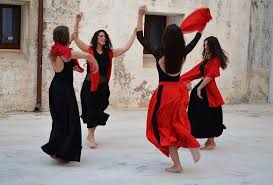Pizzica Salentina – The Dance of Healing, Passion and Tradition in Puglia
Discover the pizzica in Salento: an ancient healing dance born from tarantula myths, now the heartbeat of festivals and La Notte della Taranta.
LOCAL STORIES&CULTUREPUGLIA


Introduction:
Have you ever seen a dance that is both medicine and celebration? In Salento, the pizzica is not just music—it’s a ritual of rhythm, healing, and passion that has pulsed through villages for centuries.
The Story:
The origins of the pizzica are tied to an ancient belief: that the bite of the tarantula spider (the taranta) caused hysteria, melancholy, or trance. Women said to be “bitten” would dance wildly to the insistent rhythm of tambourines and violins, sweating and moving until the poison—and the sorrow—left their bodies. This was not only medicine but also exorcism: a community ritual where music and dance healed the afflicted.
Over time, the pizzica moved beyond its therapeutic roots. It became the heartbeat of festivals, weddings, and village gatherings, where couples danced in circles, often with flirtatious gestures and playful challenge.
Cultural Significance:
The pizzica embodies Salento’s soul: resilience, community, and the blending of sacred and profane. It’s both a memory of a rural past and a symbol of collective identity. Today, the pizzica connects generations—elders who remember the old rituals and young people who rediscover their roots through music.
The revival of the pizzica in the 1990s turned it into a cultural phenomenon. The festival La Notte della Taranta, held every August in Melpignano, is the largest folk event in Italy, where tambourines, violins, and voices rise under the stars in front of tens of thousands of people.
Traces Today:
You can hear pizzica in every corner of Salento: in Lecce’s squares, at weddings in small towns, or in concerts that mix tradition with modern sounds. In Calimera, Martano, and other villages of the Grecìa Salentina, the pizzica keeps its ancestral link to Griko culture, while in Melpignano it explodes into a modern ritual of unity.
Conclusion:
The pizzica is more than a dance—it’s a story of pain turned into joy, of women and men finding freedom in rhythm, of an entire land beating in unison. To watch or dance the pizzica is to feel Salento’s heart, ancient and eternal, under your feet
